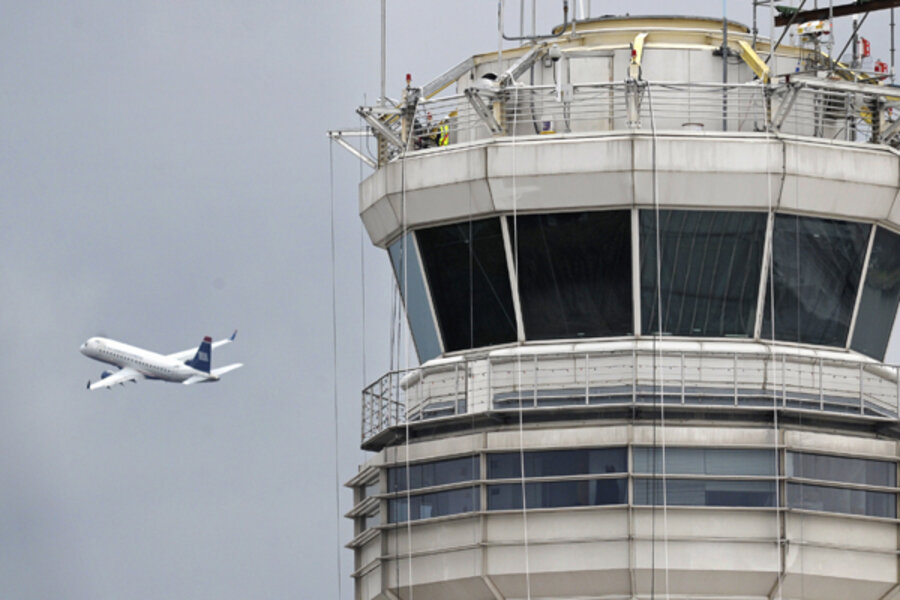3 jets near Washington never close to colliding, FAA says
Loading...
| Washington
None of the commuter jets that flew too close together near Washington was ever on course to collide head-on with the others, federal officials said Thursday.
During a news conference, U.S. Transportation Secretary Ray LaHood strongly disputed media reports characterizing the incident as a near-miss.
"At no point were the three aircraft on a head-to-head course. They were not on a collision course," said Michael Huerta, administrator of the Federal Aviation Administration.
The incident happened Tuesday because of a miscommunication between a manager at Potomac Consolidated Terminal Radar Approach Control and two traffic management coordinators at Ronald Reagan Washington National Airport, Huerta said. Officials are investigating exactly what happened. The exact nature of the miscommunication was not immediately clear.
The mishap happened at a time when traffic controllers had been changing the direction planes were landing and taking off at the airport because of bad weather developing to the south.
Both LaHood and Huerta praised the work of air traffic controllers to quickly set the planes on another path once they learned they were too close together. Huerta said the planes were on different headings at different altitudes and thus never would have crashed.
All of the planes were equipped with collision avoidance systems, but none was activated by the incident, Huerta said.
When asked by a reporter, LaHood refused to discuss what may have happened if the planes had not been diverted by the air traffic controller.
Federal guidelines require that commercial jets remain separated by at least 1,000 vertical feet and 3.5 lateral miles.
The agency said the landing plane, which departed from Portland, Maine, came within 800 vertical feet and about nine-tenths of a lateral mile of one departing plane and 800 vertical feet and 2.4 lateral miles of the second plane. The other planes had been departing for Kansas City and Columbus, Ohio.
In fiscal year 2010, the FAA recorded 1,887 operational errors, which the agency defines as a "situation in which an air traffic controller fails to maintain a safe distance between two or more aircraft, in the air or on the ground, or a safe distance from terrain, obstructions and certain airspace not designated for routine air travel." That was an increase from fiscal year 2009, in which the FAA recorded 1,234 such errors.
An audio recording of communications between the landing plane and the air traffic control tower at the airport shows confusion as the flight is given instructions on landing.
"We were clear at the river back there. What happened?" someone in the plane's cockpit says on the recording, obtained from LiveATC.com, a website that records air traffic communications.
The tower responds: "We're trying to figure this out, too. Stand by."
The landing flight then advises the tower that the plane doesn't have much fuel left: "We gotta get on the ground here pretty quick," a man says.
US Airways spokesman Todd Lehmacher said in an email that the airline is "currently investigating and working with the FAA to determine what occurred."
The airline has more than 230 daily departures from the airport to over 70 cities. U.S. lawmakers frequently fly in and out of the airport, and some members of Congress took notice of the close call.
"Such near misses and any operational errors are calls to action," said Rep. John L. Mica, R-Fla., chairman of the Transportation and Infrastructure Committee.
The airport had another high-profile safety incident in March 2011 when two airliners landed without assistance from the tower. Pilots were unable to raise the lone supervisor on duty at midnight. The supervisor later acknowledged he had fallen asleep. A second controller has since been added to the midnight shift at Reagan National.
In 2010, U.S. Rep. Jim Sensenbrenner of Wisconsin was aboard a United flight involved in a near-collision at Reagan National. He said more should be done to improve the nation's air traffic control policy and safety.
"Only better training and disciplinary action for those who violate the rules will solve the problem," Sensenbrenner said in an email.







